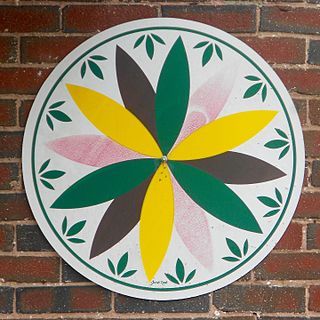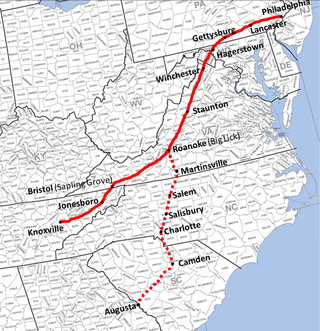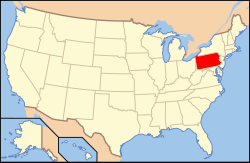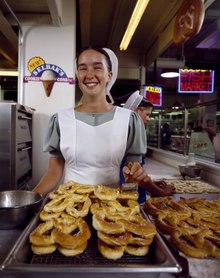
The United States does not have an official language. English and Spanish are the most widely used languages in the U.S.

Lancaster County, sometimes nicknamed the Garden Spot of America or Pennsylvania Dutch Country, is a county in the Commonwealth of Pennsylvania. It is located in the south central part of Pennsylvania. As of the 2020 census, the population was 552,984, making it Pennsylvania's sixth-most populous county. Its county seat is also Lancaster. Lancaster County comprises the Lancaster, Pennsylvania metropolitan statistical area.

The Pennsylvania Dutch, also commonly referred to as Pennsylvania Germans, are an ethnic group in Pennsylvania and other American states. They largely descend from the Palatinate region of Germany, and settled in Pennsylvania during the 17th, 18th, and 19th centuries. While most were from the Palatinate region of Germany, a lesser number were from other German-speaking areas of Germany and Europe, including Baden-Württemberg, Hesse, Saxony, and Rhineland in Germany, the Netherlands, Switzerland, and the Alsace-Lorraine region of France.

Pennsylvania Dutch, sometimes referred to as Pennsylvania German, is a variety of Palatine German, also known as Palatinate German or Palatine Dutch, spoken by the Pennsylvania Dutch, including the Amish, Mennonites, Fancy Dutch, and other descendants of German immigrants in the United States and Canada. There are approximately 300,000 native speakers of Pennsylvania Dutch in the United States and Canada.
Powwow, also called Brauche, Brauchau, or Braucherei in the Pennsylvania Dutch language, is a vernacular system of North American traditional medicine and folk magic originating in the culture of the Pennsylvania Dutch. Blending aspects of folk religion with healing charms, "powwowing" includes a wide range of healing rituals used primarily for treating ailments in humans and livestock, as well as securing physical and spiritual protection, and good luck in everyday affairs. Although the word "powwow" is Native American, these ritual traditions are of European origin and were brought to colonial Pennsylvania in the transatlantic migrations of German-speaking people from Central Europe in the seventeenth and eighteenth centuries. A practitioner is sometimes referred to as a "Powwower" or Braucher, but terminology varies by region. These folk traditions continue to the present day in both rural and urban settings, and have spread across North America.

Over 50 million Americans claim German ancestry, which makes them the largest single claimed ancestry group in the United States. Around 1.06 million people in the United States speak the German language at home. It is the second most spoken language in North Dakota and is the third most spoken language in 16 other states.

German Americans are Americans who have full or partial German ancestry. The 2020 census results showed over 44,978,546 Americans self-identifying as German alone or in combination with another ancestry. This includes 15,447,670 who chose German alone.

Dutch Americans are Americans of Dutch and Flemish descent whose ancestors came from the Low Countries in the distant past, or from the Netherlands as from 1830 when the Flemish became independent from the United Kingdom of the Netherlands by creating the Kingdom of Belgium. Dutch settlement in the Americas started in 1613 with New Amsterdam, which was exchanged with the English for Suriname at the Treaty of Breda (1667) and renamed New York City. The English split the Dutch colony of New Netherland into two pieces and named them New York and New Jersey. Further waves of immigration occurred in the 19th and 20th centuries.

The Fancy Dutch, also known as the High Dutch, are the Pennsylvania Dutch who do not belong to Plain Dutch sects. Unlike the Amish, the conservative Dunkards, or Old Order Mennonites, they do not wear plain clothing, and they fight in wars. Many popularly associated characteristics of Pennsylvania Dutch culture, including spielwerk, hex signs, and other aspects of Pennsylvania Dutch art, music, and folklore, are derived from the Fancy Dutch. The tourism industry and mainstream media often erroneously attribute such contributions to the more conservative Plain Dutch, though they would reject these aspects of their more worldly Fancy counterparts.

Hex signs are a form of Pennsylvania Dutch folk art, related to fraktur, found in the Fancy Dutch tradition in Pennsylvania Dutch Country. Barn paintings, usually in the form of "stars in circles", began to appear on the landscape in the early 19th century and became widespread decades later when commercial ready-mixed paint became readily available. By the 1950s commercialized hex signs, aimed at the tourist market, became popular and these often include stars, compass roses, stylized birds known as distelfinks, hearts, tulips, or a tree of life. Two schools of thought exist on the meaning of hex signs. One school ascribes a talismanic nature to the signs; the other sees them as purely decorative. Both schools recognize that there are sometimes superstitions associated with certain hex sign themes and neither ascribes strong magical power to them. The Amish do not use hex signs.
Theodiscus was a term used in the early Middle Ages to refer to the West Germanic languages. The Latin term was borrowed from the Germanic adjective meaning "of the people" but, unlike it, was used only to refer to languages. In Medieval Western Europe non-native Latin was the language of science, church and administration, hence Latin theodiscus and its Germanic counterparts were used as antonyms of Latin, to refer to the "native language spoken by the general populace". They were subsequently used in the Frankish Empire to denote the native Germanic vernaculars. As such, they were no longer used as antonym of Latin, but of walhisk, a language descendant from Latin, but nevertheless the speech of the general populace as well. In doing so Latin theodiscus and the Germanic reflexes of *þiudiskaz effectively obtained the meaning of "Germanic", or more specifically one of its local varieties – resulting in the English exonym "Dutch", the German endonym Deutsch, the modern Dutch word for "German", Duits, and the obsolete or poetic Dutch word for Dutch and its dialects such as Diets. In Romance languages the same word yielded the Italian word for "German", tedesco, and the old French word used for Dutch or, depending on the locality, German speakers, tiois.

Palatines are the citizens and princes of the Palatinates of the Holy Roman Empire, controlled directly by the Holy Roman Emperor. After the fall of the Holy Roman Empire in 1806, the Palatine nationality came to refer specifically to people of the Rhenish Palatinate, known simply as "the Palatinate".

The Low Countries comprise the coastal Rhine–Meuse–Scheldt delta region in Western Europe, whose definition usually includes the modern countries of Luxembourg, Belgium and the Netherlands. Both Belgium and the Netherlands derived their names from earlier names for the region, due to nether meaning "low" and Belgica being the Latinized name for all the Low Countries, a nomenclature that became obsolete after Belgium's secession in 1830.
Regions of Pennsylvania in the United States include:

A Fersommling is a Pennsylvania Dutch social event in which food is served, speeches are made, and one or more g'spiel, which are plays or skits, are performed for entertainment. "A high degree of theatricality and ceremony is involved, especially in the groundhog lodges: pledging loyalty to the lodge and the groundhog, listening to a weather report, singing patriotic songs in Deitsch, and ending every meeting by asking God to allow them to keep their way of life and their merriment." as described by William W. Donner.

The Amish, formally the Old Order Amish, are an ethnoreligious group with Swiss German and Alsatian origins. Consisting of several Anabaptist Christian church fellowships, they are closely related to Mennonites, a separate Anabaptist denomination. The Amish are known for simple living, plain dress, Christian pacifism, and slowness to adopt many conveniences of modern technology, with a view neither to interrupt family time, nor replace face-to-face conversations whenever possible, and a view to maintain self-sufficiency. The Amish value rural life, manual labor, humility and Gelassenheit. As they rarely accept converts, maintain a separate language and culture from surrounding populations, and hold their faith in common, they have been described by scholars as an ethnoreligious group, combining features of an ethnicity and a denomination.
Michael Werner is a publisher of Pennsylvania German publications and writer of Pennsylvania German articles, prose and poetry. He is the founder and publisher of the only existing Pennsylvania German newspaper, Hiwwe wie Driwwe.

The Shenandoah Valley region of Virginia and parts of West Virginia is home to a long-established German-American community dating to the 17th century. The earliest German settlers to Shenandoah, sometimes known as the Shenandoah Deitsch or the Valley Dutch, were Pennsylvania Dutch migrants who traveled from southeastern Pennsylvania. These German settlers traveled southward along what became known as the Great Wagon Road. They were descendants of German, Swiss, and Alsatian Protestants who began settling in Pennsylvania during the late 1600s. Among them were German Palatines who had fled the Rhineland-Palatinate region of southwestern Germany due to religious and political persecution during repeated invasions by French troops.

The term German Pennsylvania refers to two distinct regions:






















